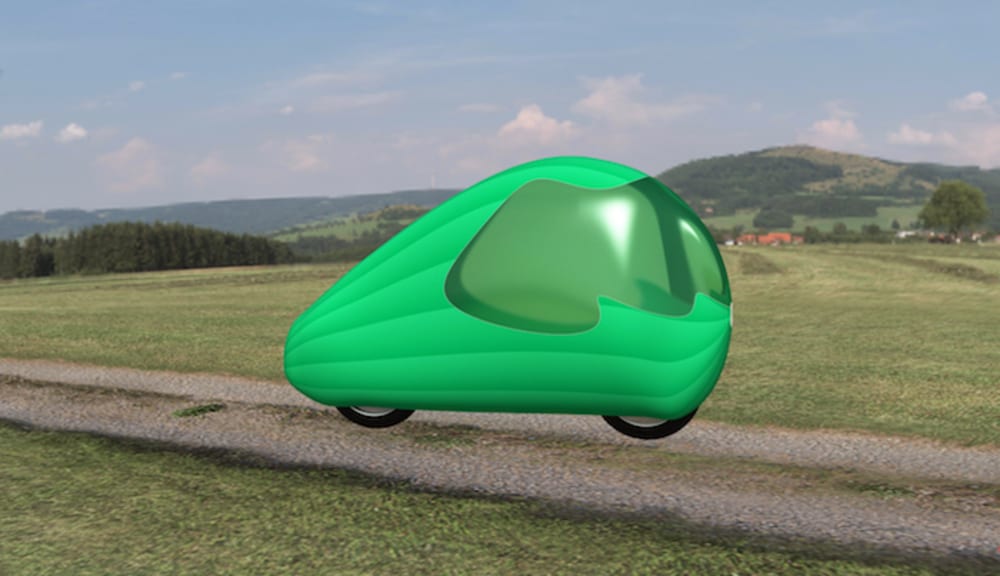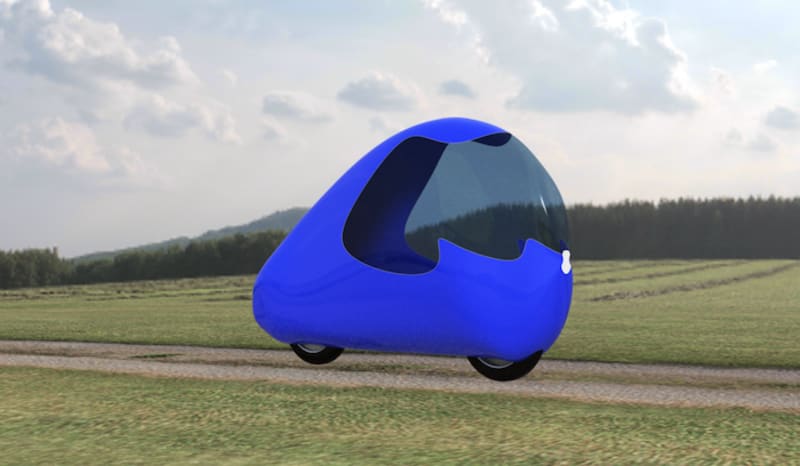The Velocity EMC (Electric Motorcycle) can be the most energy efficient and safest personal transportation on the planet. Customers are attracted to the styling, sold on the handling and safety, and rewarded with extremely low cost of ownership. The streamlined, composite exoskeleton provides excellent crash protection and all-weather comfort. Doors on both sides ensures easy entry and exits, and can be removed by the owner for warm weather rides. The Velocity EMC is uniquely energy efficient due to its advanced aerodynamic streamlining and state-of-the-art electric propulsion system. It uses just over a kiloWatt of power to cruise at 60 mph. At twelve cents per kiloWatt-hour it costs less than a quarter to travel one-hundred miles.
The Velocity EMC has a coefficient of drag of 0.09 and frontal area of 0.695 square meters producing a drag number of 0.063, or one-ninth that of a bicyclist. The streamlined shell, which makes up the exoskeleton, provide exceptional safety as well as the aerodynamic efficiency. Other attempts at producing electric motorcycles used conventional structures and fairings leading to drag coefficients around 1.0 – ten times that of the Velocity EMC. They also require ten times the power and use ten times the energy. The few enclosed motorcycles on the market all use reclined seating positions, which produce tricky handling and long learning curves. The Velocity EMC incorporates traditional rider and passenger positions straddling the seat and steering with handlebars. Riders will feel secure and confident in controlling the bike. Holding the Velocity EMC up while at stops is done by the rider pushing down on outrigger actuators with their feet inside of the vehicle. This action is similar to the rider placing their feet on the ground at stops, as usual.
Our synergy of the innovations produces the novelty. An electric motor produces less waste heat, thus allowing for the entire vehicle to be enclosed, which allows for a very strong safety enclosure, creating more security for the rider, and more utility of the vehicle. The streamlined shell reduces the drag force by as much as 90%, allowing greater acceleration and cruise speeds using a smaller, lighter motor. At 60 miles per hour, a four kiloWatt-hour battery will take the Velocity EMC past the 200 mile barrier for a single charge.
The greatest strength to weight ratio of an enclosure (using readily available materials) is foam-cored, composite sandwich construction. The electric motor & controller, batteries, suspension and steering are all external to the people space for noise and dirt control. The keel, which supports the riders’ seats internally, contains the driveline and batteries externally — under the vehicle. The enclosure manufacturing uses female modes that take the fiberglass and carbon-fiber layup, followed by CNC shaped foam, which is followed by the internal layer of composite material. This structure provides all the hard-points for mounting components within the vehicle. Many experimental aircraft are manufactured with this technology.
The primary sales channels will be through the internet with dealerships in the larger markets.
Like this entry?
-
About the Entrant
- Name:Carl Lawrence
- Type of entry:individual
- Software used for this entry:Inventor by AutoDesk
- Patent status:none








